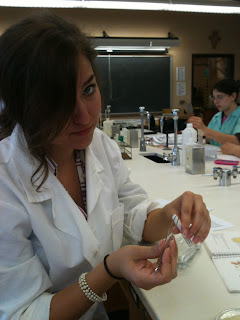We performed the Starch Hydrolysis Test next. This test is to distinguuish among bacteria in terms of their ability to hydrolyze (digest) starch.
Plants store clucose as bery large molecules called starch. Starch is made up of amylose, a long unvranched bolymer of several hundred glucose subunits, and amylopectin, a branched polymer. When plants die, bacteria in the soil digest the starch in the plant cells. The bacteria use an extracellular enzyme called amylase to hydrolyze the bonds that link the glucose subunits. The products glucose and maltose are transported across the bacterial plasma membrane, where they are used for energy and construction of other biomolecules.
Starch in a medium is detected by adding an iodide/iodine solution. When iodine reacts with starch, a purple-black color develops. If bacteria growing on starch agar produce amylase, all of the starch around the growth will be consumed after incubation. When iodine is added, no color change around the bacterial growth means that starch is no longer present. This is a positive test for starch hydrolysis.
Our result was negative, as evidenced by the lack of a clear zone around the bacteria.
Next we performed the Casein Hydrolysis Test to distinguish among bacteria in terms of their ability to hydrolyze casein, the major protein in milk.
Many bacteria secrete enzymes to hydrolyze proteins in their immediate surroundings. The resulting amino acids and peptides are then transported across cell membranes where they are used to construct bacterial proteins, to serve as carbon and nitrogen sources, and to serve as an everygy source.
Casein, the predominant protein in milkm can be used as a substrate to assess the production of proteinases by certain bacteria. When mixed with agar, casein forms a white colloid with calcium ions. When bacteria secrete caseinase, a specific protease, casein molecules are digested an the area around the bacterial growth becomes clear. This clear zone is a positive test. If the bacteria do not secrete caseinase, the medium remains white around the bacterial growth.
Our bacteria tested negative to this test.
Next was the Fat (Triglyceride) Hydrolysis Test. The purpose of this test was to determine the ability of our bacteria to hydrolyse a tryglyceride, a type of lipid.
The test medium for triglyceride hydrolysis is tributyrin agar. Tributyrin is an oily triglyceride that is emulsified with melted agar. The cooled medium appears cloudy. When bacteria growing on the medium secrete lipases that hydrolyze tributyrin, a clear zone appears around the groth. THis represents a positive test for lipid hydrolysis.
Our bacteria tested negative, as evidenced by the lack of a clear zone.
Next we performed the Gelatin Hydrolysis Test. This was to determine if our bacteria could hydrolyze gelatin.
Our bacteria tested negative, the gelatin was still solid, with no liquid.
Our bacteria also tested negative to the Triple Sugar Iron Agar Test.
It tested negative to the Litmus Milk Reactions test, as evidenced by a lack of color change.
It tested negative to the Methyl Red Test: It was clear, pale, no color.
In the Fermentation of Carbohydrates test: it tested negative to the Sucrose test, negative to the Lactose test, and Positive to the Glucose test.
It also tested negative to the Voges-Proskauer Test (Butanediol Fermentation)
Next, was the Urea Test to which our bacteria tested positive; meaning it is able to hydrolyze urea.
Next our bactera tested negative to the Indole (Tryptophan Degradation) Test. Which means that our bacteria does not use tryptophan as a source of energy.
It also tested negative to the Citrate Test, it does not utilize citrate.
Finally, we determined through the Kirby-Bauer Technique, which is used to determine the sensitivity of our bacteria to several antibacterial medicines. Our bacteria was determined to be sensitive to all of them.









No comments:
Post a Comment